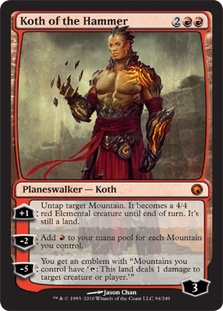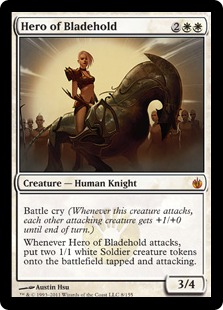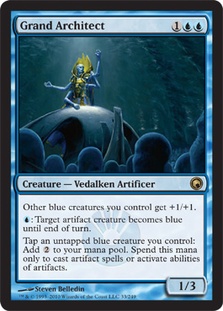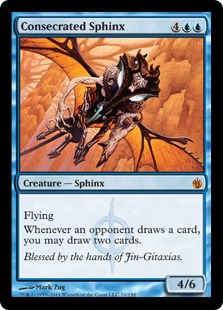Block Constructed. It’s the format that only people qualified for that Pro Tour and the Magic Online grinders care about. Not even a PTQ format,
it’s often neglected by the tournament players who strive to better themselves.
So why take the time to write about Scars of Mirrodin Block Constructed? Well it just so happens to be the Constructed portion of Pro Tour Nagoya,
which is taking place this very weekend.
Since the majority of players won’t be attending this Pro Tour, I’m going to take this opportunity to discuss the foundation of Block and how
certain key cards are going to influence deckbuilding decisions and archetypes.
Scars of Mirrodin Block Constructed is a format supported by key pillars that have archetypes formed around them. These pillars are Koth of the Hammer,
Tempered Steel, Hero of Bladehold, Tezzeret, Agent of Bolas, Grand Architect, and Consecrated Sphinx.
Looking over the pillars in the list above, the astute reader may have noticed the lack of green cards as pillars. The lack of green cards as pillars
is because green cards are meant to be more synergistic and to support archetypes. These green cards don’t impact the archetypes directly with
only two exceptions (Glissa, the Traitor and Birthing Pod).
The majority of green cards are meant to support other colors and synergize with the rest of the deck. The best examples of these cards are Viridian
Emissary, Viridian Corrupter, and Green Sun’s Zenith. These three cards are often played together in decks because they help the core color find
artifact destruction with eight cards. The Emissary is also a cheap roadblock for some of the smaller creatures of the format, and it can also attack
planeswalkers such as Tezzeret, Agent of Bolas. Lastly, it helps to fix the mana of whatever deck is playing it. Oftentimes, Viridian Emissary can
support an entire splash color, such as for Red Sun’s Zenith.
The various pillars of Block tie together the many synergistic interactions of this format. Tezzeret is a perfect example of tying decks together and
allowing them to be perfectly capable of throwing down with the most aggressive of decks. Has an opponent’s Thrun, the Last Troll got you down? A
5/5 Contagion Clasp can solve that! How about an attacking Hero of Oxid Ridge or an angry Mountain courtesy of Koth? A 5/5 Tumble Magnet can definitely
help you out of that sticky situation. Not only does Tezzeret provide a good defense against aggressive decks, but the 5/5s he creates with his -1
ability also serve admirably on offense.
But what if the Tezzeret deck is facing down a control deck? Don’t worry; Tezzeret’s got you covered there too. Simply tick up the loyalty
on Tezzeret and use him as a card advantage engine, burying your opponent with more cards than they can deal with. Eventually, he can use his ultimate
ability and drain your opponent out from 20+ life.
So how does one go about making a deck around Tezzeret? One possible start is to look at all the artifacts in the Scars block and jam them into one
deck, add four Tezzerets, and call it a day. This is the wrong approach. A good Tezzeret shell wants to have the following cards: Contagion Clasp,
Tumble Magnet, Inkmoth Nexus, Necropede, and Sphere of the Suns or Plague Myr.
So what about the rest of the deck? There are two possible directions to go with the remaining cards. The weaker option is to go straight U/B Artifact
control, utilizing cards such as Kuldotha Forgemaster to get powerhouses such as Mindslaver, Myr Battlesphere, and Blightsteel Colossus. The artifact
control option is weaker for a multitude of reasons, the first and foremost being that it relies on artifacts to win in a block filled with artifact
hate.
The games where your opponent won’t have an artifact removal spell will be few and far between. Another reason is that the deck doesn’t
really do anything to impact the board unless it has Tezzeret, Agent of Bolas. Without Tezzeret, the deck just hopes that the opponent waits long
enough for the Forgemaster to come online and fetch out a gigantic robot. This is not a winning strategy.
A winning strategy looks a little bit more like this
[deck id="38880"/]
By using artifacts that actually can attack and poison an opponent, this deck gains a major advantage. The ability to have a [card name="Sphere of the Suns"]Sphere of the Suns that
can win you the game (aka Plague Myr) makes a world of difference. It only needs to strike once, and then it can proliferate an opponent to death,
slowly poisoning them over time. It also has the other plan of dropping a Skithiryx, the Blight Dragon, giving it haste, and attacking for four poison.
Oftentimes, this is the only hit that you need to kill an opponent.
Games will often be a long, grinding attrition, trading removal spells while slowly pecking away with Inkmoth Nexus. Even if you only hit once, Tumble
Magnet and Contagion Clasp buy plenty of time to poison someone out the easy[/card] way or the hard way.
Against the pillars of the format, this deck stacks up very nicely. Phyrexian Crusader is nearly impossible for a red deck to deal with, and it slips
by all of their creatures. Not to mention the fact that Phyrexian Vatmother is another huge body that slams into creatures all day and lives to tell
the tale.
This deck is capable of playing the short game with Phyrexian Crusader, Phyrexian Vatmother, and Skithiryx; and it is also perfectly capable of playing
the long game with Tezzeret, Agent of Bolas, Inkmoth Nexus, Contagion Clasp, and Tumble Magnet.
Another pillar of the format, which all red decks are based around, is Koth of the Hammer. Koth in this format is very hard to deal with and forces
opponents to make subpar attacks to try to kill Koth. And let’s not forget that Koth makes some Mountains very angry in the meantime.
So what’s the drawback of running Koth in your deck? Why, there’s no drawback at all! You get the pleasure of running a mana base devoted almost
solely to Mountains. Now, you may be thinking to yourself, “Mountains? I heard that usually means the deck won’t be the best!”
Just because you are running upwards of twenty Mountains does not mean that your deck isn’t the best. In fact, if I were going to the
Pro Tour, I would gladly place my faith in Koth and a horde of angry Mountains. Behold, the power of Mountains.
Creatures (10)
Planeswalkers (4)
Lands (25)
Spells (21)

So, what is so appealing about this deck?
These two cards alone mean that any opponent wishing to tango with you will be in for a world of hurt if you ever get to a sufficient number of
counters on either the Shrine or on Koth. And to help out our cause, here comes our hero to save the day, Volt Charge!
Dealing three damage in this format kills a lot of creatures. Grand Architect, Argent Sphinx, Precursor Golem. All of these creatures die to Volt
Charge. Unfortunately, not every creature dies to three damage. The important creatures that don’t die to a Lightning Bolt to the face are Skithiryx,
the Blight Dragon and Hero of Bladehold.
Which leads me to the next pillar of Block.
Hero of Bladehold is a threat that most decks do not want to see. Granted, there are quite a few ways to deal with it, but if it ever
sticks around for over a turn, the game suddenly becomes a lot more one-sided.
Red decks have trouble burning out a Hero without using more than two cards or waiting until turn 5 or later (assuming they haven’t missed a land
drop or won’t be dead by then) to Red Sun’s Zenith it away.
White decks only have Arrest to deal with a Hero, and oftentimes this card won’t be maindeck or even in the sideboard of most decks.
Green decks… well, let’s not kid ourselves. Green has no removal aside from Beast Within (one of the few reasons to splash green) and
Pistus Strike, and the last time I checked, Hero of Bladehold did not have flying (although it would be pretty cool if it did).
Blue decks can counter a Hero, but that’s assuming they have time to hold up countermagic under an onslaught of creatures, which the Hero deck
presumably has.
Black decks have quite a few answers to Hero unfortunately, but that does not stop Hero from being a very powerful beater if it lives for a turn, let
alone two or more.
Let’s not forget that Hero can go into a multitude of decks.
This deck designed by Adrian Sullivan uses the idea that if you’re going to play some threats, they might as well be the most powerful threats.
White Sun’s Zenith combined with countermagic means that you never have to tap out on your own turn if you don’t want to.
Alternatively, you can just drop a turn 3 Mirran Crusader into a turn 4 Hero of Bladehold and go super beatdown. And if you happen to draw a Corrupted
Conscience on turn 5? Hope your opponent has their sideboard at the ready for the next game because this one should soon be over.
Another Hero deck is the Tempered Steel deck, which leads into the next pillar of Block.
Imagine for a second, if you will, that a format exists where every color has access to cards that hate out your deck. Now imagine that you’re
running that deck anyway. That’s one mighty powerful deck. That deck is the Tempered Steel deck.
Even if you see it coming, the Tempered Steel deck is still very capable of rolling right through you, oftentimes killing on turn 4. By playing all of
the block’s cheapest and most aggressive threats, this deck is firing on all cylinders starting turn 1. Have you ever faced an opponent who plays
almost their entire hand turn 1 followed by a turn 2 Tempered Steel? You haven’t? Well get ready to be crushed by Tempered Steel. This deck is
Block’s boogeyman, the de facto “best” deck in the format.
That is, unless you want to beat it. With great power comes great responsibility—the responsibility for other decks to pack the sufficient amount
of hate, that is.
If you want to beat the Tempered Steel deck, it’s really not that difficult to jam a sideboard full of hate cards. Creeping Corrosion (but then
again, you have to be playing green for that card, and we all know that’s a losing proposition), Revoke Existence, Divine Offering, Leonin
Relic-Warder, Slagstorm, and Black Sun’s Zenith. These are all cards that give the Tempered Steel deck fits. That is, until they play a turn 3
Mirran Crusader followed by a turn 4 Hero of Bladehold.
One of the great strengths of the Tempered Steel deck is its ability to adapt its game plan. It is quite capable of “playing fair” with
some of the most powerful creatures in the format while at the same time it is very capable of explosive draws that leave you wondering what happened.
By playing Hero of Bladehold, the opponent is forced to leave in subpar removal such as Go for the Throat, which only hits Hero and Glint Hawk. It also
lets them stare at their useless Shatters and Divine Offerings while you beat down with creatures that have some real meat on their bones.
I would expect Tempered Steel to show up in full force at the Pro Tour, proving to be a very aggressive option for players who love turning creatures
sideways.
Grand Architect is a very powerful card in a format filled with artifacts. Often, Grand Architect will play out like a ramp deck that just happens to
run a lord as well. Here is a sample decklist:
Creatures (21)
- 1 Wurmcoil Engine
- 4 Grand Architect
- 1 Myr Battlesphere
- 4 Argent Sphinx
- 1 Thopter Assembly
- 4 Treasure Mage
- 4 Plague Myr
- 2 Phyrexian Metamorph
Lands (26)
- 22 Island
- 4 Inkmoth Nexus
Spells (13)

This deck uses the abilities of Grand Architect to its fullest. Want to cast an early Wurmcoil Engine? Sure, he can do that. Want to start
proliferating with Contagion Engine? He’s got you covered there too. Let’s not forget that he’ll pump Inkmoth Nexus to allow you to
attack with a virtual 4/2.
The core of this deck is a fast mana engine with some light disruption and answers to nearly everything in the format, fetchable with Treasure Mage.
Against a red deck? Let’s go get a 6/6 monster. Want to poison someone out?
Let’s go get the proliferate machine.
Need to win a game ASAP? Maybe a giant sphere of doom is right up your alley.
A very interesting thing to note about this deck is the fact that it runs four Corrupted Consciences maindeck, really allowing you to poison someone
out with ease. Another interesting thing to note is the lack of Consecrated Sphinx, preferring large artifacts that can be powered out quickly with
Grand Architect.
Speaking of Consecrated Sphinx…
Love it or hate it, it’s the equivalent of Jace, the Mind Sculptor in this block. A card advantage machine, dealt with by only a few cards,
Sphinx will often win games if you are able to untap with it or even make it through an opponent’s draw step. It will also let you come from
behind and steal wins just by resolving it.
Just one thing to be aware of, however, is the dreaded Sphinx war. If both you and an opponent have a Consecrated Sphinx in play, welcome to the best
game of chicken that Magic has to offer. If you’re going into the opponent’s draw step, I’d definitely trigger Sphinx to draw two cards. Granted,
this will allow your opponent to draw four cards, but this trigger will allow you to draw up to eight. You can see how this can get out of control.
Sometimes declining to draw is the right play; however, if I’m in no danger of dying, I like to draw as many cards as my opponent will let me. They
have to discard down to the maximum hand size of seven; you have no such restriction on the end of their turn. Just keep in mind that being untapped
while drawing your deck is sometimes better than being tapped out and not having to discard.
Consecrated Sphinx fits very well in the U/W deck mentioned previously as well as in the sideboard of many blue decks to win the game seemingly by
itself. Consecrated Sphinx also fits very well into a U/B control shell.
Despise is one of the only ways to stop a turn 3 Koth of the Hammer on the draw, a threat that will immediately cause you a world of pain as a U/B
Control player. Dismember is a great answer to many of the problem cards, such as Hero of Bladehold, Skithiryx, the Blight Dragon, artifacts animated
by Tezzeret, Kuldotha Phoenix, and Phyrexian Vatmother.
However, I can’t recommend U/B Control knowing that there exists a large amount of Tempered Steel decks in the format. Black Sun’s Zenith
will only get you so far. Unfortunately, it does not hit Chimeric Mass (most likely at least a 5/5) or Glint Hawk Idol. Go for the Throat is also a key
component in the removal suite that’s almost a dead card against Tempered Steel.
So there you have it, the various decks of Scars of Mirrodin Block Constructed that will most likely be showing their faces at the Pro Tour this
weekend. These are the key decks based on the pillars of Block. All of these decks are highly synergistic and are built with the pillar of the deck in
mind.
There are certainly other decks out there, but without having these key cards, they’ll most likely not have the strength to stand up to these tried and
tested decks. If I were playing in the Pro tour this weekend, these decks would be the gauntlet I would test against. I would definitely play the Red
deck unless someone convinced me that creating angry Mountains was not what I wanted to be doing in this format, and as far as I can tell, it’s
exactly what I want to be doing the most.
If you have any questions at all, don’t hesitate to contact me in the forums, through Twitter (@krazykirby4), through e-mail (krazykirby AT gmail
DOT com), or on Magic Online (krazykirby4).






